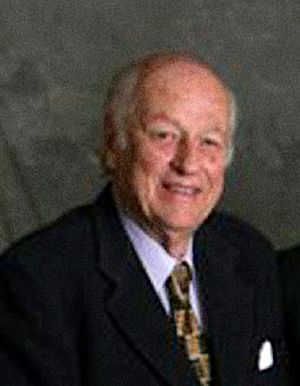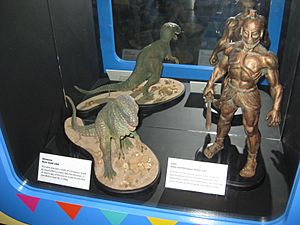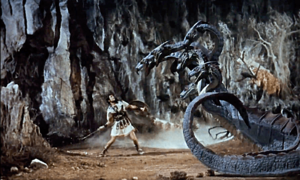Ray Harryhausen facts for kids
Quick facts for kids
Ray Harryhausen
|
|
|---|---|

Harryhausen at the Jules Verne Festival in October 2006
|
|
| Born |
Raymond Frederick Harryhausen
June 29, 1920 Los Angeles, California, U.S.
|
| Died | May 7, 2013 (aged 92) London, England
|
| Alma mater | University of Southern California Los Angeles City College |
| Occupation | Stop motion model animator |
| Years active | 1939–2010 |
| Spouse(s) |
Diana Livingstone Bruce
(m. 1963) |
| Children | Vanessa Harryhausen |
| Awards | Gordon E. Sawyer Award (Oscar for technological contributions) 1991 Inkpot Award 1992 Science Fiction Hall of Fame 2005 Rondo Hatton Classic Horror Awards 2006 |
| Signature | |
 |
|
Raymond Frederick Harryhausen (born June 29, 1920, died May 7, 2013) was a famous American-British animator. He created amazing special effects for movies. He used a special type of stop-motion animation called "Dynamation".
His famous works include the animation for Mighty Joe Young (1949). He also worked on The 7th Voyage of Sinbad (1958), his first movie in color. Another well-known film is Jason and the Argonauts (1963). This movie has a famous sword fight with seven skeleton warriors. His last movie was Clash of the Titans (1981). After this, he stopped making films.
In 1960, Harryhausen moved to the United Kingdom. He became a citizen of both America and Britain. He lived in London until he passed away in 2013. Many filmmakers today say Ray Harryhausen's special effects inspired them. These include Steven Spielberg, Peter Jackson, James Cameron, and George Lucas.
Contents
Ray Harryhausen's Early Life
Ray Harryhausen was born in Los Angeles, California. His family was of German background.
Ray Harryhausen's Career in Film
Starting in the 1930s and 1940s
When Ray was young, he watched the movie King Kong (1933). He loved the stop-motion animation in it. This movie inspired him to try making his own animated short films. He met Willis H. O'Brien, the animator who worked on King Kong. O'Brien gave Ray advice on how to improve his skills.
Ray studied art and photography in college. He also became friends with a writer named Ray Bradbury. They both loved science fiction.
During World War II, Ray worked for the United States Army. He made short animated films about military equipment. After the war, he used old film to make short films based on fairy tales.
In 1947, Ray worked as an assistant animator on Mighty Joe Young (1949). This was his first big movie.
The 1950s and Dynamation
Ray Harryhausen's first movie where he was in charge of all the special effects was The Beast from 20,000 Fathoms (1953). This movie was a big success.
For The Beast From 20,000 Fathoms, Ray used a new technique he created called "Dynamation". This method allowed him to combine animated models with live-action scenes. He would split the background and foreground of a filmed scene. Then, he would animate his models in between these two parts. This made it look like the animated creatures were really in the movie with the actors.
Ray worked mostly by himself on his animation. His father helped by making the metal skeletons for the models. These skeletons allowed the models to move and hold their positions. His mother helped with tiny costumes for the models.
Ray then started working with producer Charles H. Schneer. Their first movie together was It Came from Beneath the Sea (1955). This film was about a giant octopus attacking San Francisco. It was very popular. Next, they made Earth vs. the Flying Saucers (1956), which was about an alien invasion.
In 1957, they made 20 Million Miles to Earth. This movie was about an alien creature from Venus that grows very large on Earth. Ray made the alien, called the Ymir, look very real and emotional. This movie was also a big hit.
Schneer wanted to make movies in color. Ray worked hard to make his Dynamation process work well with color film. This led to his biggest hit of the 1950s, The 7th Voyage of Sinbad (1958). This movie was one of the most popular films of that year.
The 1960s and Famous Creatures
Ray and Charles Schneer continued to make successful films. These included The 3 Worlds of Gulliver (1960) and Mysterious Island (1961).
His next movie is often seen as his best work: Jason and the Argonauts (1963). This film has many famous animation scenes. One is a long fight between actors and seven living skeletons. This scene took over four months to create.

After this, Ray made First Men in the Moon (1964). However, Jason and First Men in the Moon did not do as well at the box office. This meant his contract with Columbia Pictures was not renewed.
Ray then worked for Hammer Films. He animated the dinosaurs for One Million Years B.C. (1966). This movie was very popular. He then made another dinosaur film, The Valley of Gwangi (1969). This movie was a special project for Ray. It was based on ideas from his mentor, Willis O'Brien.
The 1970s and 1980s
Ray and Charles Schneer brought back the Sinbad character. They made The Golden Voyage of Sinbad (1973). This film is famous for a sword fight with a statue of the six-armed goddess Kali. It was a big success. They followed it with Sinbad and the Eye of the Tiger (1977). Both movies did well at the box office.
Ray's last feature film was Clash of the Titans (1981). This was a bigger budget film with famous actors. For this movie, he had other animators help him. The film featured creatures like the Medusa and the giant Kraken. Ray was nominated for an award for his special effects in this movie.
Even though Clash of the Titans was very successful, new computer technology was changing special effects. Because of this, studios did not want to fund his next planned movie. So, Ray Harryhausen retired from making films.
Later Years and Legacy
After retiring, Ray focused on writing books about his work. He also helped restore his films for release on DVD and Blu-ray. He wrote Film Fantasy Scrapbook and Ray Harryhausen: An Animated Life.
Ray remained friends with Ray Bradbury and Forrest J Ackerman. He also stayed close with his producer, Charles H. Schneer.
In 1986, Ray started the Ray & Diana Harryhausen Foundation. This group works to keep his collection safe. It also helps promote the art of stop-motion animation.
Ray Harryhausen had small acting roles in a few movies. He was in the 1998 remake of Mighty Joe Young. He also voiced a polar bear cub in the movie Elf.
Awards and Honors
In 1992, Ray Harryhausen received the Gordon E. Sawyer Award. This is a special Oscar for his important contributions to film technology. Actor Tom Hanks and his friend Ray Bradbury presented him with the award. Tom Hanks even said Jason and the Argonauts was the greatest film ever made!
Many other honors came his way. In 2005, he was inducted into the Science Fiction Hall of Fame. In 2010, he received an honorary BAFTA award.
Ray Harryhausen's Death and Influence
Ray Harryhausen married Diana Livingstone Bruce in 1962. They had a daughter named Vanessa. Ray passed away on May 7, 2013.
Many famous filmmakers have said that Ray Harryhausen's work inspired them. Steven Spielberg, James Cameron, Peter Jackson, and George Lucas are among them. George Lucas said, "Without Ray Harryhausen, there would likely have been no Star Wars". Terry Gilliam noted that what filmmakers now do with computers, Ray did long ago with his own hands.
John Walsh, who wrote a book about Harryhausen, called him "the most influential stop-motion animator and special-effects wizard in cinema history."
The Ray & Diana Harryhausen Foundation
Ray left his collection of film items to the Ray & Diana Harryhausen Foundation. This foundation protects his work and promotes stop-motion animation. His daughter, Vanessa Harryhausen, is a trustee of the foundation.
The foundation works to restore his collection. They also share his work with the public. In 2013, a biography film called Ray Harryhausen – Special Effects Titan was released.
In 2016, the foundation started a podcast about Ray Harryhausen. It talks about his films and models.
Many of Ray's models and artwork have been shown in exhibitions. These include shows at the Barbican Centre in London and the Science Museum Oklahoma.
In 2020, a large exhibition of his models opened at the Scottish National Gallery of Modern Art in Edinburgh. It was to celebrate 100 years since his birth. His daughter, Vanessa, also wrote a book called Ray Harryhausen: Titan of Cinema.
In 2021, the Ray Harryhausen Award was created. It celebrates Ray's influence on new filmmakers and animators.
Filmography
Feature Films and Creatures Animated
- Mighty Joe Young (1949)
- Mighty Joe Young (a giant gorilla)
- The Beast from 20,000 Fathoms (1953)
- Rhedosaurus (a dinosaur)
- It Came from Beneath the Sea (1955)
- A giant octopus
- The Animal World (1956, documentary)
- Various dinosaurs like Brontosaurus and Allosaurus
- Earth vs. the Flying Saucers (1956)
- 20 Million Miles to Earth (1957)
- The Ymir (an alien creature)
- The 7th Voyage of Sinbad (1958)
- The 3 Worlds of Gulliver (1960)
- Mysterious Island (1961)
- Jason and the Argonauts (1963)
- First Men in the Moon (1964)
- Moon Cow, Selenite (moon creatures), Grand Lunar
- One Million Years B.C. (1966)
- Various dinosaurs like Brontosaurus, Allosaurus, Triceratops
- The Valley of Gwangi (1969)
- Gwangi (an Allosaurus), Styracosaurus
- The Golden Voyage of Sinbad (1973)
- Sinbad and the Eye of the Tiger (1977)
- Clash of the Titans (1981)
Short Films
- Mother Goose Stories (1946)
- The Story of Little Red Riding Hood (1949)
- The Story of Hansel and Gretel (1951)
- The Story of King Midas (1953)
Interviews and Acting Roles
- Spies Like Us (1985) – Dr. Marston
- Beverly Hills Cop III (1994) – Bar Patron
- Mighty Joe Young (1998) – Gentleman at Party
- Elf (2003) – Polar Bear Cub (voice)
- Burke & Hare (2010) – Distinguished Doctor
Images for kids
See also
 In Spanish: Ray Harryhausen para niños
In Spanish: Ray Harryhausen para niños








